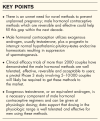Testosterone and male contraception
- PMID: 39155802
- PMCID: PMC11556877
- DOI: 10.1097/MED.0000000000000880
Testosterone and male contraception
Abstract
Purpose of review: Rates of unintended pregnancy have remained relatively stagnant for many years, despite a broad array of female contraceptive options. Recent restrictions on access to abortion in some countries have increased the urgency for expanding contraceptive options. Increasing data suggest men are keen to utilize novel reversible male contraceptives.
Recent findings: Despite decades of clinical research in male contraception, no reversible hormonal product currently exists. Nestorone/testosterone, among other novel androgens, shows promise to finally move to pivotal Phase 3 studies and introduction to the marketplace.
Summary: Hormonal male contraception utilizes androgens or androgen-progestin combinations to exploit negative feedback that regulates the hypothalamic-pituitary-testicular axis. By suppressing release of gonadotropins, these agents markedly decrease endogenous testosterone production, lower intratesticular testosterone and suppress spermatogenesis. The addition of a progestin enhances the degree and speed of sperm suppression. The androgen component preserves a state of symptomatic eugonadism in the male. There is growing demand and acceptance of male contraceptive options in various forms. As these formulations progress through stages of drug development, regulatory oversight and communication with developers around safety and efficacy standards and garnering industry support for advancing the production of male contraceptives will be imperative.
Copyright © 2024 The Author(s). Published by Wolters Kluwer Health, Inc.
Conflict of interest statement
Figures


References
-
- Bearak J, Popinchalk A, Ganatra B, et al. . Unintended pregnancy and abortion by income, region, and the legal status of abortion: estimates from a comprehensive model for 1990-2019. Lancet Glob Health 2020; 8:e1152–e1161. - PubMed
Publication types
MeSH terms
Substances
LinkOut - more resources
Full Text Sources
Research Materials

